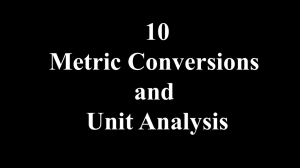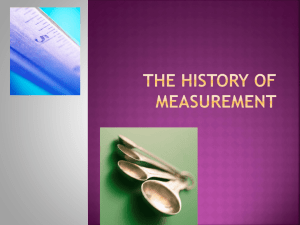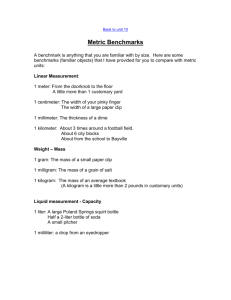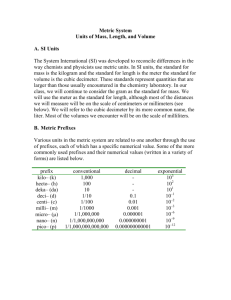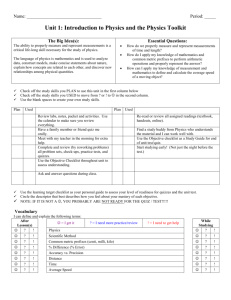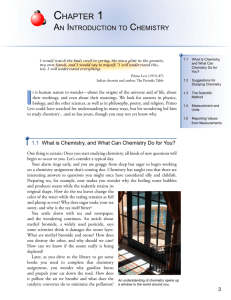Skill Building Topic 1
advertisement
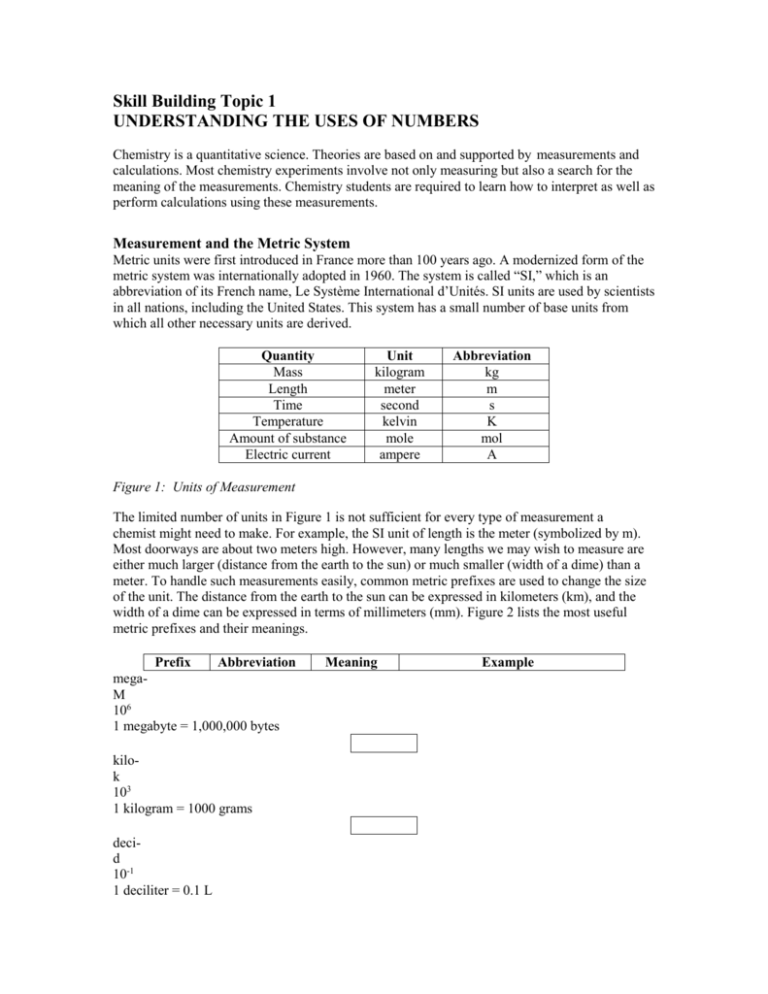
Skill Building Topic 1 UNDERSTANDING THE USES OF NUMBERS Chemistry is a quantitative science. Theories are based on and supported by measurements and calculations. Most chemistry experiments involve not only measuring but also a search for the meaning of the measurements. Chemistry students are required to learn how to interpret as well as perform calculations using these measurements. Measurement and the Metric System Metric units were first introduced in France more than 100 years ago. A modernized form of the metric system was internationally adopted in 1960. The system is called “SI,” which is an abbreviation of its French name, Le Système International d’Unités. SI units are used by scientists in all nations, including the United States. This system has a small number of base units from which all other necessary units are derived. Quantity Mass Length Time Temperature Amount of substance Electric current Unit kilogram meter second kelvin mole ampere Abbreviation kg m s K mol A Figure 1: Units of Measurement The limited number of units in Figure 1 is not sufficient for every type of measurement a chemist might need to make. For example, the SI unit of length is the meter (symbolized by m). Most doorways are about two meters high. However, many lengths we may wish to measure are either much larger (distance from the earth to the sun) or much smaller (width of a dime) than a meter. To handle such measurements easily, common metric prefixes are used to change the size of the unit. The distance from the earth to the sun can be expressed in kilometers (km), and the width of a dime can be expressed in terms of millimeters (mm). Figure 2 lists the most useful metric prefixes and their meanings. Prefix Abbreviation megaM 106 1 megabyte = 1,000,000 bytes kilok 103 1 kilogram = 1000 grams decid 10-1 1 deciliter = 0.1 L Meaning Example centic 10-2 1 centimeter = 0.01 m millim 10-3 1 milliampere = 0.001 A microu 10-6 1 micrometer = 10-6 m nanon 10-9 1 nanometer = 10-9 m picop 10-12 1 picometer = 10-12 m Figure 2: Common Metric Prefixes Quantities can be converted from one unit to another through the use of equivalences from Figure 2 and a unit conversion factor. Example 1: Convert 1456 g to kilograms. Equivalence: 1 kilogram = 1 × 103 g From the equivalence we create a unit conversion factor. This is a fraction in which the numerator is a quantity that is equal to the quantity of the denominator—except the numerator is expressed in different units. A unit conversion factor is equal to one. Conversion factor: 1kilogram 1 103 gram or 1 103 gram 1kilogram The conversion factor is chosen to cause the original unit to cancel and the desired unit to remain. Multiplication: 1456 g 1kg 1.456 kg 1 10 3 g More than one conversion factor can be used in a single problem. Example 2: Convert 325 mg to kilograms. Equivalences: 1 g =1 × 103 mg Conversion Factors: 1g 1 10 mg Multiplication: 325mg 3 and 1 kg 1 10 3 g 1g 1kg 3.25 10 4 kg 3 3 1 10 mg 1 10 g Converting units in this manner is called dimensional analysis or factor labeling. Dimensional analysis can be used to solve many different types of problems in chemistry. For further instruction on dimensional analysis, see the next section. Remember that all numbers in chemistry are an outcome of a measurement. As a result, numbers should have a measurement unit associated with them. Always include units when you write numbers. Complex Units Frequently we wish to measure quantities that cannot be expressed using only one of the basic SI units. In these situations, two or more units are combined to create a new, “derived” unit. For example, speed is the ratio of distance to time. To measure speed, two units—distance and time—are combined. Another derived unit frequently used in the laboratory is volume. Let us see how these derived units are related to SI units: The volume of a cube is determined by multiplying (length × width × height). A cube with sides 3 of 10 cm × 10 cm × 10 cm has a volume of 1000 cm , which is defined as one liter. 1000 cm3 = 1 liter (1 L) Density is the ratio of mass to volume (D = m/v), so it is also a derived unit. It is an important property for determining the identity of a sample of matter. Again, two units are combined—a mass unit and a volume unit. The density of solids and liquids is usually expressed as g/cm3 and the density of gases as g/L. Skill Building Topic 1 UNDERSTANDING THE USES OF NUMBERS Practice Exercises Complete the following. 1. Which metric unit and prefix would be most convenient to measure each of the following? a. the diameter of a giant sequoia tree _____________________ b. the diameter of a human hair _____________________ c. time necessary to blink your eye _____________________ d. mass of gasoline in a gallon _____________________ e. mass of a cold virus _____________________ f. _____________________ amount of aspirin in a tablet g. mass of concrete to pave a parking lot _____________________ 2. What word prefixes are used in the metric system to indicate the following multipliers? a. 1 × 103 _____________________ b. 1 × 10-3 _____________________ c. 0.01 _____________________ d. 1 × 10-6 ___________________ 3. An antacid tablet contains 168 mg of the active ingredient ranitidine hydrochloride. How many grams of the compound are in the tablet? Answer: _______________________ 4. There are 1.609 km in 1 mile. Determine the number of centimeters in a mile. Answer: _______________________ 5. A paper clip is 3.2 cm long. What is its length in millimeters? Answer: _______________________ 6. The average person in the United States uses 340 L of water daily. Convert this to milliliters. Answer: _______________________ 7. A quart is approximately equal to 946 mL. How many liters are in 1 quart? Answer: _______________________ 8. One hundred fifty milliliters of rubbing alcohol has a mass of 120 g. What is the density of rubbing alcohol? Answer: _______________________ 3 9. A ruby has a mass of 7.5 g and a volume of 1.9 cm . What is the density of this ruby? Answer: _______________________ 10. What is the density of isopropyl alcohol if 5.00 mL weigh 3.93 g? Answer: _______________________ 11. State at least one advantage of SI units over the customary US units. ___________________________________________________________________________ ___________________________________________________________________________ ___________________________________________________________________________ ___________________________________________________________________________ ___________________________________________________________________________
